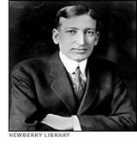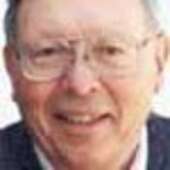Burlington's Ralph Budd in McCook
Monday, May 16, 2011

Ralph Budd
By October 1935, life in McCook and Southwest Nebraska had begun to return to normal after the ravages of the Memorial Day flood, which had killed more than 100 people, swept away thousands of farm animals, laid ruin to farm buildings and thousands of acres of prime farm land in the Republican Valley, downed hundreds of miles of telephone and power lines, and destroyed miles of railroad bed and tracks of the Burlington Railroad, which skirted the banks of the Republican River through the entire length of the Valley. It was time to mark the region's remarkable recovery from that flood.
In McCook, a central point of the flood, there was a celebration, put on by the citizens of the city, but greatly supported by the Burlington Railroad -- a celebration the likes of which had never been seen before (or duplicated since).
There was no shortage of celebrities in McCook -- led by former U.S. Vice President, Charles C. Dawes (more recently Ambassador to England). Dawes was a former resident of Nebraska, having spent eight years in the state -- "the best eight years of my life." He was known for his salty language, and delighted the crowd with his observations, thankfully described with a minimum of "damns", and 'hell 'n marias."
But there were many others -- Frank B. Kellogg, another former Ambassador to England, Governors Roy Cochran, Nebraska, Alf Landon, Kansas, Edwin Johnson Colorado, and Clyde Herring, Iowa. Major General Frank Bolles, with a crack equestrian team from the 7th Army, was here, among other dignitaries, all on hand to congratulate the hearty survivors of the flood on their remarkable recovery.
But perhaps the most important dignitary in town for the celebration was the congenial president of the Burlington Railroad, Ralph Budd, who presided at a private Burlington party in the city park, at which he thanked the Burlington employees for the splendid, speedy job they had performed in getting the railroad back to normal in record time. He emphasized that they should be proud of the work they had done, and their association with Burlington.
It was through Budd's influence that a number of important people attended the celebration, and it was at his insistence that significant events occurred. In an interview with Harry Strunk, Ralph Budd indicated that the Burlington Railroad wanted to make the celebration special. He had arranged that a nationwide broadcast over the CBS network be originated in McCook. This would certainly focus the nation's attention on Southwest Nebraska, but it would also publicize the world land speed record that would be set by the Burlington's Mark Twain Zephyr -- and hopefully give a boost to rail travel.
Ralph Budd was something of a legend in the Railway world. An Iowa farm boy, he had earned an civil engineer's degree at Des Moines' Highland Park College, and immediately took a job with Great Chicago Railroad. Advancements were quick, and in 1902 he accepted a job with the Rock Island Pacific Railroad. It was here that he met one of the deans of American Civil Engineering, John Frank Stevens. When Stevens was tapped by President Theodore Roosevelt to oversee the construction of the Panama Canal, Budd went with him, and at age 27 supervised, and completed (ahead of schedule) the railroad across the Isthmus of Panama, through a very rough jungle terrain.
Budd's Panamanian success brought him to work for the Great Northern Railroad, where he supervised the construction of the 7.9-mile Cascade tunnel in Central Washington, still one of the longest RR tunnels in the world. He was chosen by Great Northern President, James Hill to be his successor at Great Northern, and at age 40 became the youngest President of any major Railroad.
In 1932 Budd became the President of the Burlington Railroad. This was a very bad time for railroads. In addition to the strains of the great Depression, the railroads were suffering from stiff competition from the automobile industry. By 1932 they had lost fully one fourth of their passenger business, and President Budd was determined to reverse that trend.
Ralph Budd was influenced by two men, Edward Budd (no relation), and Charles Kettering, of General Motors. Edward Budd had produced sleek bodies for the auto industry, and Kettering had developed a superior diesel engine. Ralph Budd persuaded Edward Budd to build him a sleek, stainless steel railroad train, which would be powered by the GM diesel engine. It was a beauty, and was introduced to the public at the Chicago World's Fair, in 1933. Ralph Budd called his train a Zephyr, after Zephyrus, "the gentle, nurturing wind" described by Chaucer in his "Canterbury Tales."
In 1935 President Budd thought that one of his Zephyrs was ready to challenge the world speed record for railroads of 120 mph, held by the Germans. The run for the new record was to be made by the brand new Burlington Zephyr, Mark Twain, on the newly repaired Burlington tracks, from McCook to Oxford, on Wednesday, Oct. 23.
Excursions to and from Oxford were planned aboard the Mark Twain at 10:30, 3:30, and 8:30. A steam train followed the Zephyr, so that passengers (for $1) could ride the Mark Twain one way. At 1 p.m., the Mark Twain made its record run. For that run only railroad executives and members of President Budd's party were allowed to ride on the historic train. (This group included Edward Budd and the Vice President of GM.)
The Mark Twain easily surpassed the all American records on the historic trip to Oxford, attaining speeds of 122 mph, and maintaining the speed of 121 mph for seven miles. Hundreds of spectators gathered to watch the spectacle between Arapahoe and Oxford, where the record speed was set. The train "speeded around heavy curves at 91 mph without discommoding passengers standing in the aisle."
Passing Edison at 119 mph, an order was given to "give 'er the gun."
"Hanging onto its throttle, open to the fullest, Engineer Jack Ford ... put the diesel power motors to their fullest capacity ... a cheer broke out as the speedometer hit 122 mph, "leaving no doubt that the record had been smashed."
More observations from the Gazette, "Little evidence of the Memorial Day Flood remains ... farms have been rehabilitated ... corn as good as any produced in Eastern Nebraska is ready for the huskers."
President Budd and his party headed for Denver after their historic ride, while the Mark Twain headed to Chicago for regular service on the Burlington line. There was much talk about the success of the McCook Reclamation celebration ... "unprecedented!"
Ralph Budd went on to a distinguished career with the Burlington Railroad, as an executive and a mentor. Historian Richard Overton wrote, "The Burlington, with Ralph Budd at the helm, was a virtual training school for railway executives. In the years following, most of the key executives for all railroads could say that they had worked for the Burlington and Ralph Budd in some capacity." At his retirement in 1949, James Lynn said, "The Burlington was essentially the lengthened shadow of Ralph Budd."
After he retired Budd spent five years as President of the Chicago Transit Authority, but turned down a professorship at Northwestern, saying he felt he did not have the qualifications to teach."
Ralph Budd left his mark on the railroad industry to be sure, and he was also responsible for a significant event in McCook's history. Mr. Budd retired (for good) to California in 1954. He died in 1962. He was 83.
Source: McCook Gazette, October 1935; American Experience/People, Ralph Budd

